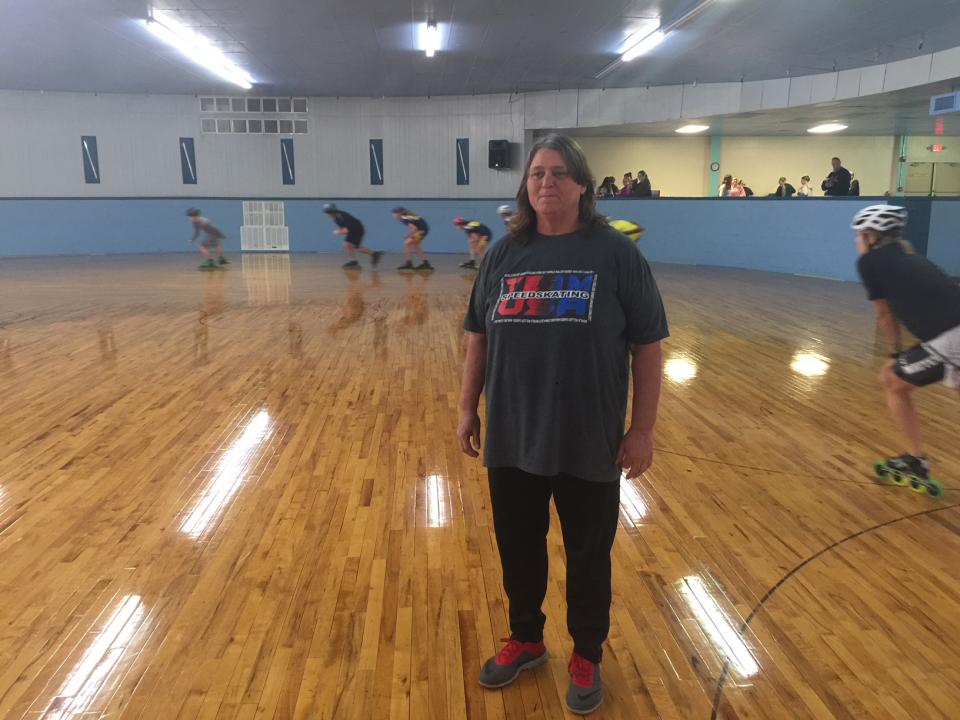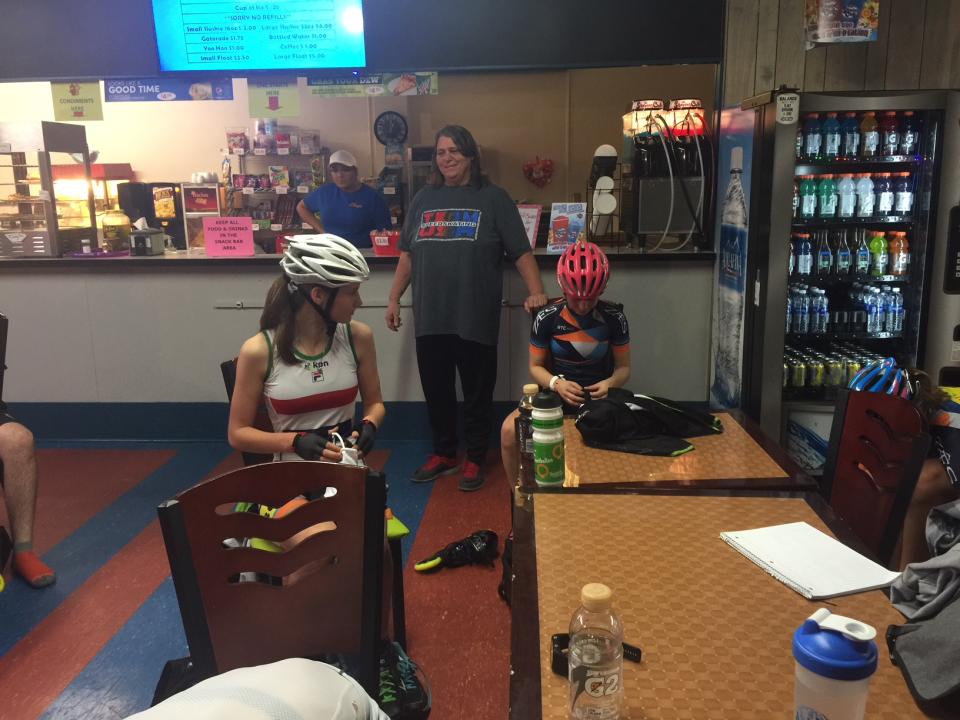How a Florida town with no ice rink produced three Olympic speedskaters

OCALA, Fla. – Here in this old horse town, down the road from Darrell’s Dog Gone Good Diner, in the lot behind the Save A Lot food stores, through the flimsy wooden door, past the snack bar and Ms. Pac Man arcade game, there stands a grandmother with a booming voice and graying, stringy hair.
This woman holds the key to Winter Olympics glory.
Next month, Renee Hildebrand will send three athletes to the Games in South Korea: Joey Mantia, Brittany Bowe and Erin Jackson. They are all speedskaters, all from here, a town with no ice rink.
Jackson has trained on ice for only a total of four months of her life. She is now the first African-American woman ever to make the U.S. long-track team.
“I was more than surprised,” she says of her qualification. “It didn’t make any sense. I didn’t understand it.”
[Stream the NFL Playoffs live on the Yahoo Sports mobile app]
Nobody really understands it. At Olympics trials, someone came up to Hildebrand and effused: “You’re the best developmental ice coach in the country!” Hildebrand said thanks but added, “I don’t coach ice.”
Meet the woman who built a winter mecca out of a roller rink behind a Save A Lot in Central Florida. Meet the Oracle of Ocala.
Hildebrand grew up in Lakeland, about 45 minutes south of here, and she always wanted to be a world champion roller skater. She got her start on the four-wheel, two-by-two skates and studied sports medicine so she could coach as well. In the early ’90s, she moved to Ocala for a job as a physical therapist, and at around that time, inline skates came out. It was as if the entire roller world hit a reset button. The tiers of the sport were slashed to the ground and someone like Hildebrand could leap to the top of the game if she could master inlines.
“It put me on a level playing field,” she says. “We all had to coach inlines.”

Since inlines mirrored speedskating on ice, she studied a book by Olympic gold medalist Dianne Holum. She absorbed the importance of technique and body positioning, and she became proficient in tutoring both.
The goal was always to win Olympics gold in inline. She still has a roller skating bumper sticker from 1980 that says, “Next stop, the Olympics.” But there was a problem: The sport never made it into the Games.
So although she got very good at coaching inline and even roller derby, the ultimate dream was not available. Unless …
In 2002, Derek Parra, a former inline skater who spent time in Tampa, won gold in speedskating at the Salt Lake Games. Others followed, including Chad Hedrick, who won gold four years later.
The kids Renee trained, Mantia and Bowe, made the switch as teens. Joey moved from Florida to Colorado and then Utah to train, and within three years he was beating teammate Shani Davis and world champion Denis Yuskov. It was almost the exact same trajectory for Bowe, who had played college hoops at Florida Atlantic before moving to Salt Lake. Less than four years after switching to ice, they were Olympians.
But the most amazing story was yet to come.
And it began in a Waffle House.
Erin Jackson’s mom, Rita, loved the Southern staple, and she would always order the Texas Toast. When you spend that much time at Waffle House, sometimes you get to know the regulars. One of the regulars was a local inline coach known as “Nasty Nay.”
Hildebrand assumed the name for her demeanor but because every derby skater has a handle. In real life she loved coaching and when inline skating invariably came up in conversation, Erin’s mom mentioned her 10-year-old daughter. Hildebrand started working with the little girl, and after some time she had a Derby name of her own: “Miss Jax’em.”
There wasn’t much in Erin’s background that screamed “elite athlete.” Her dad, Tracy, built fire trucks. Rita was a pharmacy tech. Even Erin herself was more interested in schoolwork; she would go to the University of Florida and major in materials engineering.
But she loved to skate and Nasty Nay loved to teach. The coach always said that it’s not “practice makes perfect,” it’s “perfect practice makes perfect.” Renee was a true stickler and Erin was a true student.
“She’s really great at training her skaters physically and mentally,” Erin says. “She’s a very motivational person. She helps her skaters believe in themselves.”
But one thing Renee couldn’t do was motivate Erin to try ice. Her first time on blades came during a European trip in September 2016. Only the following March, in 2017, did she finally venture out to Salt Lake City to train.
“I didn’t have plans to come back beyond that,” Erin says. “I didn’t want to wonder what could have been if I didn’t try ice. Then I figured, ‘I’ll go back to the life I love in Florida.’ ”
She did just that, and like all of Hildebrand’s protégés, she was immediately very good at the frozen version of her sport. Still, she returned to Florida and put off traveling back to Utah as long as she could. Earlier this month, she went to trials after only putting in four total months on ice. Hildebrand had never seen her skate on ice.
She made the Olympic team.
“It was shock and disbelief,” she says. “I couldn’t pinpoint what I was thinking at that moment.”
Before too many more moments passed, she was thinking about her mom.
In 2011, Jackson traveled to Argentina for an inline tournament. Back home, Rita wasn’t well. She had dealt with diabetes and some heart-related issues. Communication was sporadic; Erin’s phone wasn’t readily picking up signals. When she returned home, she learned her mom had gone into surgery. She lost consciousness and eventually lost oxygen to her brain. She passed away the next day.
It hadn’t been that long since the days when Rita and Renee were sharing meals at the Waffle House, talking about the spritely little girl they both thought the world of. Now that girl was an Olympian, and her mom was gone.
“I wish she could be here to see this,” Erin says.

On an abnormally cool Saturday afternoon in January, Renee Hildebrand stands in the middle of the Skate Away South roller rink as her students whizz by. “Stay low, stay low!” she yells. A short distance away, a birthday party goes on, with children and parents pausing every now and then to look at the action on the rink. The practice has to end soon, as public skate starts at 2. In a few minutes the snack bar will be packed and the ’80s music will play and the fluorescent lights will dance on the awkward teens and the too-brave speed demons and the graying couples out on an afternoon date.
Three of the skaters here are from Holland. They traveled all this way for Nasty Nay; word travels fast in the skating world. They’ve been here for a few weeks already, leaving their speedskating-rich nation to get some wisdom in “Slo-cala” Florida. “Only thing fast is the horses and the skaters,” Renee likes to say.
The skaters here won’t stop when the roller rink switches over. They’ll just pack up and drive to an outdoor high school track nearby. That’s where they’ll work for another hour on conditioning and technique. Hildebrand guesses one of the advantages of practicing inline over ice is the ability to train longer. She says ice training is more tiring, so less gets accomplished during a particular practice.
Whatever it is, it’s working. And it’s weird. Ocala is becoming one of the world’s epicenters for ice skating, and there’s no rink and not even a decent outdoor inline track. The only testament to the success here is the bulletin board in the Skate Away snack bar, which has photos of Erin and Joey and Brittany and all their medals and trophies. One can only assume that will change if any of the three win an Olympic medal next month.
“It’s really exciting to be this sort of pioneer,” Erin says. “People kind of gravitate to those who represent them. Young women and people of color can look at me and say, ‘She’s doing this and maybe I can do it too.’ ”
Out at the high school track, two boys arrive for practice. They are ages 12 and 8, and they already have speed to burn. One of the families moved here from Georgia just to train with Hildebrand. They are the next generation.
She is the Oracle of Ocala, and at age 55 she’s just beginning. She just has to figure out a way to watch her prized pupils in South Korea. Because she’s not officially on the team, Nasty Nay will have to buy tickets and sit in the stands.
More from Yahoo Sports:
• Wetzel: Sexual molester Larry Nassar played the victim in court
• The heat on Seelers coach Mike Tomlin is justified … to a point
• Kris Dunn busts teeth in scary post-dunk fall
• Landon Donovan un-retiring again is so Landon Donovan
• Mel Kiper has Josh Allen going No. 1

